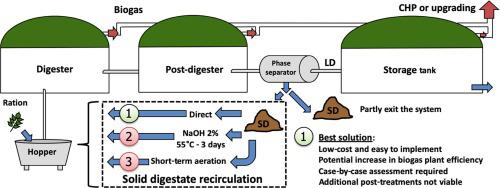Energy Conversion and Management ( IF 10.4 ) Pub Date : 2021-02-03 , DOI: 10.1016/j.enconman.2020.113759 Ulysse Brémond , Aude Bertrandias , Raphaëlle de Buyer , Eric Latrille , Julie Jimenez , Renaud Escudié , Jean-Philippe Steyer , Nicolas Bernet , Hélène Carrere

|
This article aims at providing insight into the recirculation of (post-treated) solid digestate (SD) within digesters. Such a practice has been further identified as promising for anaerobically digesting recalcitrant feedstocks and for improving the energy efficiency of continuously stirred tank reactor (CSTR) agricultural biogas plants. Firstly, implementation strategies and the potential impact of SD direct recirculation on five CSTR biogas plants were investigated. According to the selected strategy, results indicated that plant methane production could rise by 0.6 to 6.3% or that a potential feedstock shortage of 64 to 1431 tons/year could be compensated. Secondly, the relevance of additional post-treatments for improving these initial results was evaluated. Thermo-chemical post-treatments successfully increased SD biodegradability by 30 to 46% although their costs were not compensated by additional methane production. Short-term aerobic post-treatments failed in increasing SD biodegradability (up to 21% loss in biomethane potential). Hence, at full scale, a quick and direct recirculation of SD excluding any post-treatment appears to be the optimal condition to apply. Finally, conditions for the full-scale implementation of direct SD recirculation were theoretically studied. This practice has proved to increase the solid retention time by 11 to 38% and the plant total solid content by 6 to 20%. Thus, the critical point for its implementation should be the capacity of the plant mixing system to handle such an increase in solids. The relevance of SD recirculation needs to be determined on a case-by-case basis. Consequently, for the first time, this article provides a framework where the conditions can be identified for direct SD recirculation to be a relevant digestate management practice. Overall, this article demonstrates how direct SD recirculation can be a simple and low-cost mean for improving agricultural CSTR biogas plant efficiency. It also highlights the importance of achieving efficient digestate management in the biogas sector in order to reduce the costs of biogas production.
中文翻译:

固体消化物的再循环以提高沼气厂的能源效率:策略,条件和影响
本文旨在深入了解蒸煮器内(后处理的)固体消化物(SD)的再循环。这种做法已被进一步确认为厌氧消化顽固性原料并提高连续搅拌釜反应器(CSTR)农业沼气厂的能源效率的希望。首先,研究了SD直接再循环对5台CSTR沼气厂的实施策略和潜在影响。根据选定的策略,结果表明,工厂甲烷产量可提高0.6%至6.3%,或者可弥补每年64至1431吨的潜在原料短缺。其次,评估了其他后处理对改善这些初步结果的相关性。热化学后处理成功地将SD的生物降解性提高了30%至46%,尽管其成本并未获得额外的甲烷生产补偿。短期有氧后处理未能提高SD的生物降解性(生物甲烷气潜力最多损失21%)。因此,在不进行任何后处理的情况下,从规模上看,SD的快速直接再循环似乎是适用的最佳条件。最后,从理论上研究了直接实施SD再循环的条件。实践证明,这种方法可使固体保留时间增加11%至38%,使植物总固体含量增加6%至20%。因此,其实施的关键点应该是植物混合系统应对这种固体含量增加的能力。SD循环的相关性需要根据具体情况确定。因此,本文首次提供了一个框架,在其中可以确定直接SD再循环的条件,以作为相关的消化管理实践。总体而言,本文证明了直接SD再循环如何成为提高农业CSTR沼气厂效率的简单且低成本的手段。它还强调了在沼气领域实现有效的消化管理的重要性,以降低沼气生产成本。本文演示了直接SD再循环如何成为提高农业CSTR沼气厂效率的简单且低成本的手段。它还强调了在沼气领域实现有效的消化管理的重要性,以降低沼气生产成本。本文演示了直接SD再循环如何成为提高农业CSTR沼气厂效率的简单且低成本的手段。它还强调了在沼气领域实现有效的消化管理的重要性,以降低沼气生产成本。


























 京公网安备 11010802027423号
京公网安备 11010802027423号